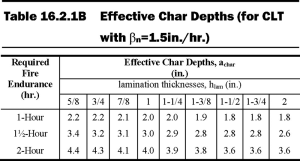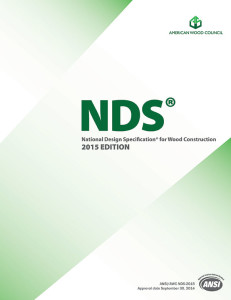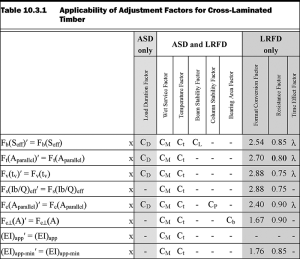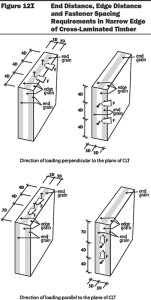The 2015 Edition of the National Design Specification® (NDS®) for Wood Construction was recently published. The updated standard designated ANSI/AWC NDS-2015 was approved as an ANSI American National Standard on September 30, 2014 (Figure 1). The 2015 NDS was developed by the American Wood Council’s (AWC) Wood Design Standards Committee and is referenced in the 2015 International Building Code (IBC).
Primary changes to the 2015 NDS are listed here, and major topics are subsequently covered in more detail:
- Incorporation of cross-laminated timber (CLT) in several chapters of the NDS, including a new product chapter specific to CLT
- Addition of terminology for laminated strand lumber and oriented strand lumber
- Clarification that withdrawal design values for lag screws excludes the length of the tapered tip
- Inclusion of char rates for CLT and structural composite lumber
- Relocation of reference to Special Design Provisions for Wind and Seismic (SDPWS)
Cross-Laminated Timber
The primary change to the 2015 NDS is incorporation of design provisions for CLT. To keep CLT with other product chapters (4-9), Chapter 10 is renamed Cross-Laminated Timber and each subsequent chapter is renumbered accordingly. The one-sentence reference to SDPWS in 2012 NDS Chapter 14 was moved to Section 1.1.1.4, which allows Chapters 15 and 16 to remain unchanged.
In NDS Chapter 3, a time dependent deformation (creep) factor for design of CLT was added. The factor of 2.0 is associated with use in dry service conditions and is consistent with the factor of 2.0 for wood structural panels used in dry service conditions. For column design, CLT is associated with a “c” factor equal to 0.9 for calculation of the column stability factor, CP, consistent with glulam.
The new CLT Chapter 10 is consistent with other product chapters in the NDS (Figure 2) but most closely modeled after Chapter 9 for wood structural panels. The applicable product standard for CLT is ANSI/APA PRG 320 Standard for Performance-Rated Cross-Laminated Timber, and applicable design values are to be obtained from manufacturer’s literature or code evaluation report.
Connection provisions were revised to accommodate CLT in Chapter 12, Dowel-Type Fasteners. A new section applicable for lag screw withdrawal from CLT’s narrow edge (top, bottom, left or right edge) was added. For lag screws loaded in withdrawal from the narrow edge, the end grain factor, Ceg = 0.75, is applicable regardless of actual grain orientation. While the Ceg factor is normally applied only to end grain applications in other wood products, application to all grain orientations in narrow edges of CLT is intended to conservatively account for the mix of end grain and side grain in the narrow edge of a CLT panel where the minimum edge distance requirements for lag screws cannot be maintained (as opposed to small diameter nails and wood screws).
New sections applicable for wood screw and nail withdrawal from end grain of CLT were added. The approach of not recognizing wood screw or nail withdrawal from end grain of CLT is consistent with existing provisions for wood screws and nails in end grain of other wood products. The Ceg = 0.0 factor is added to clarify that there is no design strength associated with such applications.
New sections were added to address determination of dowel bearing strengths for fasteners installed in CLT. For fasteners installed in the panel face, dowel bearing strength is based on direction of loading with respect to the grain orientation of the CLT ply at the shear plane. Where the loading direction is parallel to the grain at the shear plane, a reduced bearing length approach is used to account for the effect of reduced bearing strengths in perpendicular to grain orientations in adjacent layers. For fasteners installed in the narrow edge, dowel bearing strength perpendicular to grain, Fe[pmath]ortho[/pmath], is the applicable bearing strength where fastener diameter, D≥¼ inch, and is intended to account for: 1) presence of end grain bearing in the connection, and 2) end distance, edge distance, and spacing of fasteners that would not otherwise comply with NDS provisions for placement for D≥¼ inch if applied to individual laminations of a CLT panel. For example, if the CLT panel is comprised of three 1½-inch thick laminations, the total thickness would be 4½ inches. Meeting edge distance requirements for 1½-inch laminations might not be possible. For fasteners with D<¼ inch, a single value of Fe is the applicable bearing strength.
Reduced bearing lengths are used to account for perpendicular grain orientations in crossing laminations where fasteners are installed in the panel face, penetrate multiple laminations, and are loaded parallel to the face grain.
A new section, table, and Figure 3 includes end distance, edge distance, and spacing requirements for fasteners in the narrow edge of CLT. Fastener placement provisions are based on CLT cross section dimensions as opposed to individual laminations within the CLT. End distance, edge distance, and spacing requirements for fasteners in the panel face of CLT should be designed in accordance with existing NDS requirements for these fasteners in other wood products.
A new section for lag screws loaded laterally in the narrow edge of CLT was added. For lag screws installed in the narrow edge of CLT and loaded laterally, in addition to use of Fe[pmath]ortho[/pmath] for dowel bearing strength, the connection design value must also be adjusted by the end grain factor, Ceg = 0.67, regardless of whether the fastener is installed in end grain or side grain. The factor is normally applied to end grain applications only, but for CLT it is intended to conservatively account for the mix of end grain and side grain in the narrow edge, and to address difficulties in meeting minimum edge distance requirements if applied to individual laminations of the CLT. For fasteners with D<¼ inch, Ceg = 0.67 is applicable where the fastener is installed in end grain.
Chapter 13, Split Ring and Shear Plate Connectors, clarifies that provisions for design of these types of connections are not directly applicable to CLT. Possible considerations for their use, as part of an engineered design, would need to include requirements for end and edge distance, spacing, and effects of perpendicular crossing laminations.
Chapter 14, Timber Rivets, consistent with design of shear plate and split ring connectors in CLT, clarifies that provisions for design of timber rivet connections are not directly applicable to CLT.
Chapter 16, Fire Design of Wood Members, includes a char rate model for CLT based on observations from testing. Accordingly, a new effective char depth equation and table for CLT were added (Figure 4).

Figure 4. Effective char depth table excerpted from 2015 NDS Chapter 16 Fire Design of Wood Members.
Structural Composite Lumber
In Chapter 8 on Structural Composite Lumber, terminology was added for LSL (laminated strand lumber) and OSL (oriented strand lumber). Structural composite lumber products LSL and OSL are addressed in ASTM D5456 Standard Specification for Evaluation of Structural Composite Lumber Products, but have not previously been defined within the NDS. Added product definitions for LSL and OSL are consistent with those in ASTM D5456.
Chapter 16, Fire Design of Wood Members, was also revised to address structural composite lumber products (PSL, LVL, and LSL).
Withdrawal Design Values for Lag Screws
Chapter 12, Dowel-Type Fasteners, clarifies that the withdrawal design value for a lag screw excludes the length of the tapered tip. The addition of “excluding the length of the tapered tip” is consistent with the Table 12.2A table heading which says the length of thread penetration “shall not include the length of the tapered tip.”
NDS Supplement
The 2015 NDS Supplement: Design Values for Wood Construction incorporates new design values for southern pine. The American Lumber Standard Committee (ALSC) Board of Review approved changes to design values for all grades and all sizes of visually-graded Southern Pine and Mixed Southern Pine lumber with a recommended effective date of June 1, 2013. Additionally, new and revised grades of machine stress-rated lumber and machine evaluated lumber are also included in the 2015 NDS Supplement.
More Details
A comprehensive table listing section by section changes to the NDS is available in a web version of this paper available at www.awc.org.
Availability
The 2015 NDS with 2015 NDS Supplement is currently available for purchase in electronic format (PDF) only. Once the NDS Commentary and other support documents to be included in the 2015 Wood Design Package (WDP) are updated, printed copies will be available for purchase. Once the NDS Commentary and other support documents are complete, those who purchased electronic versions of the 2015 NDS and 2015 NDS Supplement will receive those documents in electronic format at no additional charge. Check the AWC website for status updates on the 2015 WDP.
Conclusion
The 2015 NDS represents the state-of-the-art for design of wood members and connections. Reference to the 2015 NDS in the 2015 IBC will make it a required design standard in those jurisdictions adopting the latest building code. However, building officials have the option to accept designs prepared in accordance with newer reference standards even if the latest building code has not been adopted in their jurisdiction. IBC 104.11 for alternate materials and design provides the authority having jurisdiction with that flexibility.▪



